#177: Coprinoid Mushrooms
Coprinoid mushrooms are easy to recognize, at least in theory. Many coprinoid mushrooms have gills that liquefy (“deliquesce”) at maturity, which readily distinguishes them from normal agarics. These fungi produce purple-brown to black spores, so liquefied gills often end up looking like an inky mess. As a result, coprinoid mushrooms are often called “Inky Caps.” Coprinoid mushrooms with gills that do not deliquesce can be identified by their central stipes, dark spores, and relatively thin and fragile flesh.
Description
If classic, toadstool-type mushrooms are like golf umbrellas, then coprinoid mushrooms are like parasols. Coprinoid mushrooms have a central stipe and a pileus that is usually conic to bell-shaped. In some species, the pileus becomes flat in age and maybe even upturned. These mushrooms generally have thin, fragile flesh, but there are a few more substantial species. The gills are either free or attached to the stipe and often liquefy at maturity.1 If the gills deliquesce, it proceeds from the outside in so that the gills liquefy just as the spores become mature.2 Because of the thin flesh and deliquescence, these mushrooms are ephemeral. I find they often disappear completely by noon. Coprinoid mushrooms produce very dark spore prints, which helps distinguish the group from most other mushrooms. The spores range in color from black to purple-brown.1 The mushrooms may or may not have a partial veil and/or universal veil. Currently, inky caps are divided among four genera: Coprinellus, Coprinopsis, Parasola, and Coprinus.1,2
Coprinellus and Coprinopsis make up the bulk of the inky caps and most closely match the general description above. The two genera are very similar, so you should use a recent key to accurately differentiate between the two genera.2 As far as I can tell (based on information from 2006), Coprinellus does not have a partial veil (and therefore has no ring) and lacks deliquescent gills while Coprinopsis has a partial veil that leaves a ring and has deliquescent gills.1 Additionally, Coprinopsis species more often produce universal veils that leave warts or patches.3
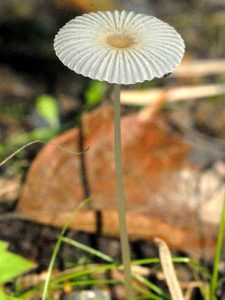
Parasola contains some of the most fragile coprinoid mushrooms. Photo by James Lindsey at Ecology of Commanster [CC BY-SA 2.5 or CC BY-SA 3.0], via Wikimedia Commons.
Coprinus is characterized by large, sturdy inky caps. These mushrooms have thick flesh compared to other coprinoid mushrooms but their gills do liquefy, making it impossible to confuse them with any other group.1 Coprinus species also have a partial veil that leaves a ring, a cord-like bundle of hyphae that runs up the center of the stipe, and gills that often start pinkish before turning black.2 Many Coprinus mushrooms, such as the well-known C. comatus, feature scaly caps that are nearly cylindrical before they begin to open.1
The genera Psathyrella and Panaeolus are sometimes included in the coprinoid mushrooms. I decided to include them here because they are closely related to the main group of coprinoid mushrooms4 and because they generally have darker spore prints than the strophariaceae.1 None of the mushrooms in Psathyrella or Panaeolus have deliquescent gills, so they’re usually not called “Inky Caps.”
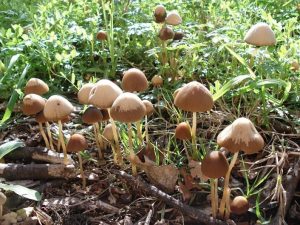
Psathyrella species are known for their stipes that easily snap in half. Many, including the ones pictured above, change color upon drying out. Photo by CureCat (Own work) [CC BY 3.0], via Wikimedia Commons.
Panaeolus consists mainly of “Little Brown Mushrooms” (LBMs). These mushrooms are small, are grayish or brownish, have thin flesh, have conic or bell-shaped pilei, produce a purple-brown to black spore print, and have gills that are mottled with various shades of black.1,6 Their small size means that they display relatively few features and are not particularly interesting.
Coprinoid mushrooms are all saprobic and spend their time decaying various plant and animal matter. Inky caps grow on a variety of substrates, including: dung, grass, wood, and leaf litter.1,2 Psathyrella species generally grow on various types of plant debris, although the group includes at least one mycotroph.1,5 Panaeolus is commonly found on horse and cow dung but may also appear on other animal feces, in grassy areas, and on leaf litter.1,6,7
Identifying Coprinoid Mushrooms to Species
Most coprinoid mushrooms are difficult to identify down to species. There are a few species in each genus that are easy to pick out. Most people learn a few edible species and ignore the rest. Beyond that, things get complicated very quickly. One problem you’ll encounter is that morphological features quickly disappear in deliquescent species. Even if you have a good specimen, you may be stymied by the heavy reliance on microscopic examination or by the lack of good keys to species in your region. If you’re determined to try and identify your (not distinctive) mushroom down to species, be prepared for a lot of work. Before you get in too far, try the keys linked at the bottom of this page. For delving into the inky caps, try this site, which uses names that are now out of date. For an in-depth study of Psathyrella, check out The North American Species of Psathyrella by Alexander Smith (available online here).
Similar Species
Black-spored coprinoid mushrooms without deliquescent gills are difficult to confuse with any other group of mushroom. The closest match would be the Gomphidiaceae (FFF#178), which have gray to black spore prints but feature thick flesh and decurrent gills. Coprinoid mushrooms are much more dainty and have free or attached gills.1
Coprinoid mushrooms that produce lighter spores and do not deliquesce are more difficult to separate from other mushroom groups. The spore print color could also be found in Agaricus (FFF#174) or the stropharioid mushrooms (FFF#185). However, Agaricus produces stocky mushrooms with thick flesh, which means you are unlikely to confuse them with the dainty inky caps. Unfortunately, there is more morphological variety among stropharioid mushrooms. Most stropharioid mushrooms have thicker flesh than inky caps, but both groups include LBMs. Panaeolus can often be separated from other LBMs thanks to its mottled gills. Most Psathyrella species can be distinguished by stipes, which easily snap in half. If your LBM doesn’t key out with the coprinoid mushrooms, try looking at stropharioid mushrooms.1,8 LBMs are not very well treated in field guides because they are notoriously difficult to separate from one another. If you really want to identify your LBM, you’ll need a good key and a microscope.
Edibility
Coprinoid mushrooms include edible species as well as poisonous species with a wide variety of toxins. The three most commonly eaten coprinoid mushrooms are probably Coprinus comatus, Coprinopsis atramentaria, and Coprinellus micaceus. Of these, C. comatus is the most sought-after. Obviously, you should collect only young specimens for the table. Liquefied coprinoid mushrooms do not make a pleasant meal. Some coprinoid species, such as the “edible” C. atramentaria, contain the toxin coprine (FFF#095) and can make you sick if you drink alcohol with your mushrooms. Panaeolus includes some species that produce the hallucinogenic compounds psilocybin and psilocin (FFF#098). Apparently, some people eat those for their hallucinogenic properties. However, given that most Panaeolus species are LBMS, I think most people would consider them too small to bother with.1,7
Taxonomy
Thanks to DNA sequencing, the inky caps recently went through a few taxonomic changes. Up until the 1990’s, all inky caps were placed in the genus Coprinus. In 1994, mycologists sequencing mushroom DNA discovered that the DNA of C. comatus was very different than that of most other inky caps. Amid mounting evidence to support that finding, the genus was split into four genera in 2001. Coprinellus, Coprinopsis, and Parasola contained the bulk of the inky caps and were assigned to the family Psathyrellaceae. Coprinus ended up with a mere handful of species and was assigned to the family Agaricaceae. This makes Coprinus more closely related to Agaricus (FFF#174) and the lepiotoid mushrooms (FFF#173) than to any other inky caps. The other genera are more closely related to Panaeolus and Psathyrella, which I described above. Since the inky caps belong to two different lineages, deliquescent gills must have evolved at least twice, providing yet another great example of convergent evolution.2,3
So why did Coprinus end up with just a few inky caps? Since it was the original inky cap genus, shouldn’t it have gotten most of them? The reason Coprinus ended up so small is that its type species was C. comatus. When taxonomists create a new genus, they have to assign that genus a “type species,” or a particular species they think is most typical of that genus. This is useful because it tells future taxonomists, “genus X should include all the species that are similar to species Y.” Long before 2001, mycologists decided that C. comatus was the quintessential Coprinus. So, when it came time to split up the genus, the mycologists had to remove all the mushrooms that were unlike C. comatus. Unfortunately, that included the majority of the species in Coprinus. In 2007, some mycologists proposed changing the type species of Coprinus to C. atramentarius,* which would have kept the name Coprinus with the largest genus of inky caps. This change was not made and we ended up with the four genera as they are today.3
Genetic studies of coprinoid mushrooms are ongoing, so many of the mushrooms in these genera are likely to get shuffled around in the future. The most important mushrooms, such as the popular edibles, are probably the most thoroughly studied and will probably keep their names. More complete genetic studies may also result in new genera. Psathyrella is currently a very large genus, which means mycologists will probably split it up. For example, some Psathyrella mushrooms will probably get moved into the genus Lacrymaria.2,5
| Kingdom | Fungi | Fungi |
| Division | Basidiomycota | Basidiomycota |
| Subdivision | Agaricomycotina | Agaricomycotina |
| Class | Agaricomycetes | Agaricomycetes |
| Subclass | Agaricomycetidae | Agaricomycetidae |
| Order | Agaricales | Agaricales |
| Family | Agaricaceae | Psathyrellaceae |
| Genus | Coprinus Pers.9 | Coprinellus P. Karst.10
Coprinopsis P. Karst.11 Panaeolus (Fr.) Quél.12 Parasola Redhead, Vilgalys & Hopple13 Psathyrella Fr. ex Quél.14 |
* I referred to C. atramentarius earlier, but then I called it C. atramentaria. Why did the name change slightly? Down here, I am talking about the mushroom being considered part of the genus Coprinus. Based on the rules of Latin, that genus name is male and the specific epithet must also be male: Coprinus atramentarius. Today, the mushroom belongs to the genus Coprinopsis, which is female. When that change happened, mycologists had to change the ending of the specific epithet to match the gender of its new genus: Coprinopsis atramentaria.
This post describes a group of mushrooms and as such the information on this page (including the pictures) cannot be used to identify any mushroom in particular.
This post does not contain enough information to positively identify any mushroom. When collecting for the table, always use a local field guide to identify your mushrooms down to species. If you need a quality, free field guide to North American mushrooms, I recommend Michael Kuo’s MushroomExpert.com. Remember: when in doubt, throw it out!
See Further:
http://www.mushroomexpert.com/coprinoid.html
http://www.svims.ca/council/Coprin.htm
http://www.mushroomexpert.com/psathyrella.html
http://www.svims.ca/council/Psathy.htm
http://www.mushroomexpert.com/panaeolus.html
http://www.svims.ca/council/Panaeo.htm
https://www.jstor.org/stable/1224525?seq=1#fndtn-page_scan_tab_contents
http://quod.lib.umich.edu/cgi/t/text/text-idx?c=fung1tc;idno=AJN6254.0001.001
http://www.grzyby.pl/coprinus-site-Kees-Uljee/species/Coprinus.htm#A
Citations
- Miller, O. K. & Miller, H. North American mushrooms: a field guide to edible and inedible fungi. (Falcon Guide, 2006).
- Michael Kuo. Coprinoid Mushrooms: The Inky Caps. MushroomExpert.Com (2008). Available at: http://www.mushroomexpert.com/coprinoid.html. (Accessed: 10th February 2017)
- Dr. Fred Van De Bogart. Trial Field Key to COPRINOID SPECIES in the Pacific Northwest. Pacific Northwest Key Council (2017). Available at: http://www.svims.ca/council/Coprin.htm. (Accessed: 10th February 2017)
- Michael Kuo. The Genus Psathyrella. MushroomExpert.Com (2011). Available at: http://www.mushroomexpert.com/psathyrella.html. (Accessed: 10th February 2017)
- Ian Gibson. PSATHYRELLA in the Pacific Northwest. Pacific Northwest Key Council (2007). Available at: http://www.svims.ca/council/Psathy.htm. (Accessed: 10th February 2017)
- Michael Kuo. The Genus Panaeolus. MushroomExpert.Com (2007). Available at: http://www.mushroomexpert.com/panaeolus.html. (Accessed: 10th February 2017)
- Gary Menser. Trial field key to the species of PANAEOLUS in the Pacific Northwest. Pacific Northwest Key Council (2003). Available at: http://www.svims.ca/council/Panaeo.htm. (Accessed: 10th February 2017)
- Michael Kuo. Key to Dark-Spored, Gilled Mushrooms. MushroomExpert.Com (2014). Available at: http://www.mushroomexpert.com/gilled_dark.html. (Accessed: 10th February 2017)
- Names Record: Coprinus Pers., Tent. disp. meth. fung. (Lipsiae): 62 (1797). Index Fungorum Available at: http://www.indexfungorum.org/names/NamesRecord.asp?RecordID=17367. (Accessed: 10th February 2017)
- Coprinellus. Mycobank Available at: http://www.mycobank.org/BioloMICS.aspx?TableKey=14682616000000067&Rec=100007&Fields=All. (Accessed: 9th February 2017)
- Coprinopsis. Mycobank Available at: http://www.mycobank.org/BioloMICS.aspx?TableKey=14682616000000067&Rec=348946&Fields=All. (Accessed: 9th February 2017)
- Panaeolus. Mycobank Available at: http://www.mycobank.org/BioloMICS.aspx?Table=Mycobank&Rec=57077&Fields=All. (Accessed: 9th February 2017)
- Parasola. Mycobank Available at: http://www.mycobank.org/BioloMICS.aspx?TableKey=14682616000000067&Rec=101912&Fields=All. (Accessed: 9th February 2017)
- Psathyrella. Mycobank Available at: http://www.mycobank.org/BioloMICS.aspx?Table=Mycobank&Rec=34492&Fields=All. (Accessed: 9th February 2017)

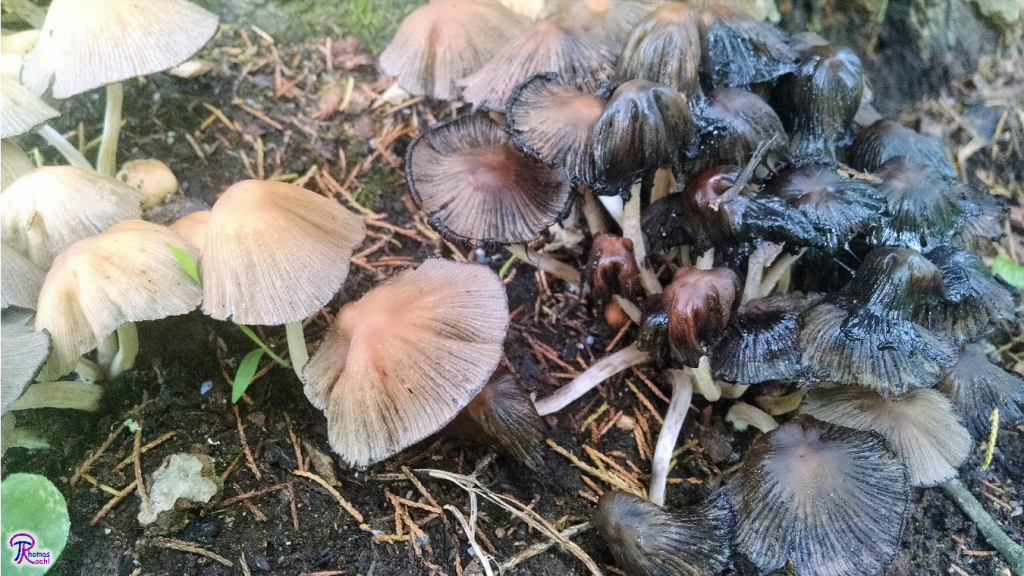
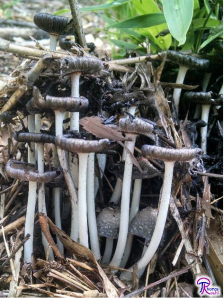






![#011: Characteristics of Kingdom Fungi [Archived]](https://www.fungusfactfriday.com/wp-content/themes/hueman/assets/front/img/thumb-small-empty.png)

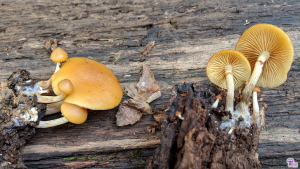
8 Responses
[…] is only one other group of mushrooms with black spores: the coprinoid mushrooms (inky caps, FFF#177). Coprinoid mushrooms are thin and fragile and/or have gills that liquefy, which readily […]
[…] (FFF#174) species, non-deliquescent coprinoid mushrooms (FFF#177), Bolbitaceae species, and cortinarioid mushrooms can all appear similar to stropharioid mushrooms. […]
[…] Coprinoid11,27,28 […]
[…] commonly known as “The Mica Cap” or “The Glistening Inkcap” is one of the rare inky caps (FFF#177) that is easy to identify. These medium-sized mushrooms appear in dense clusters on dead wood and […]
[…] in the Psathyrellaceae lineage of inky caps,6 which means it is related to coprinoid mushrooms (see FFF#177) in the genera Coprinopsis, Parasola, and Psathyrella but unrelated to the well-known inky caps in […]
[…] spores into the air, the asci of C. petersii liquefy (“deliquesce” like inky cap gills, see FFF#177) to make a spore-containing slime that slowly exudes out of the perithecia. This creates the dark […]
[…] now contains all the inky caps except the Shaggy Mane (Coprinus comatus) and its relatives.6 See FFF#177 for more on inky cap […]
[…] have evolved in two separate lineages and the genus Coprinus had to be pared down quite a bit (see FFF#177). The Blushers definitely belong to the genus Amanita (FFF#172), although their exact placement […]